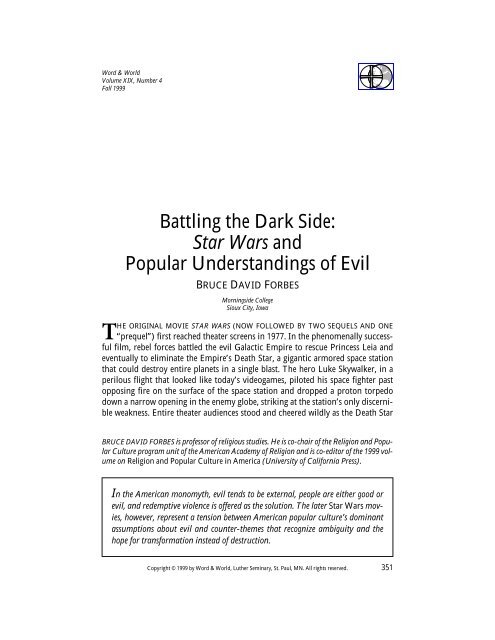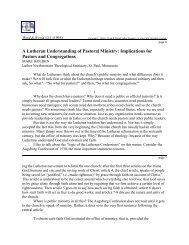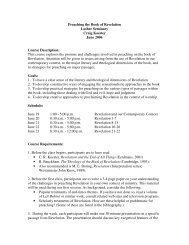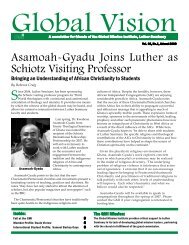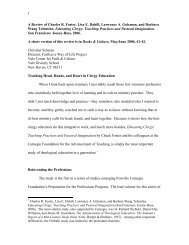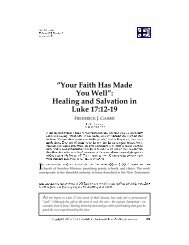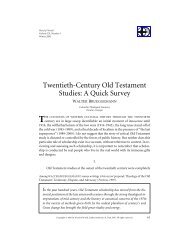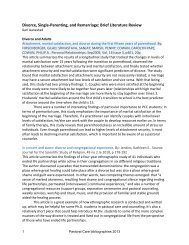Download Article PDF - Word & World - Luther Seminary
Download Article PDF - Word & World - Luther Seminary
Download Article PDF - Word & World - Luther Seminary
Create successful ePaper yourself
Turn your PDF publications into a flip-book with our unique Google optimized e-Paper software.
<strong>Word</strong> & <strong>World</strong>Volume XIX, Number 4Fall 1999Battling the Dark Side:Star Wars andPopular Understandings of EvilBRUCE DAVID FORBESMorningside CollegeSioux City, IowaHE ORIGINAL MOVIE STAR WARS (NOW FOLLOWED BY TWO SEQUELS AND ONE“prequel”) first reached theater screens in 1977. In the phenomenally successfulfilm, rebel forces battled the evil Galactic Empire to rescue Princess Leia andeventually to eliminate the Empire’s Death Star, a gigantic armored space stationthat could destroy entire planets in a single blast. The hero Luke Skywalker, in aperilous flight that looked like today’s videogames, piloted his space fighter pastopposing fire on the surface of the space station and dropped a proton torpedodown a narrow opening in the enemy globe, striking at the station’s only discernibleweakness. Entire theater audiences stood and cheered wildly as the Death StarBRUCE DAVID FORBES is professor of religious studies. He is co-chair of the Religion and PopularCulture program unit of the American Academy of Religion and is co-editor of the 1999 volumeon Religion and Popular Culture in America (University of California Press).In the American monomyth, evil tends to be external, people are either good orevil, and redemptive violence is offered as the solution. The later Star Wars movies,however, represent a tension between American popular culture’s dominantassumptions about evil and counter-themes that recognize ambiguity and thehope for transformation instead of destruction.Copyright © 1999 by <strong>Word</strong> & <strong>World</strong>, <strong>Luther</strong> <strong>Seminary</strong>, St. Paul, MN. All rights reserved. 351
Forbesis a systematically arranged set of answers to basic life-problem questions,” andNelson organized the answers in five categories:1. shared views of what is unsatisfactory about present experience2. shared views about the source of that unsatisfactory situation3. shared views of the nature of the delivering force through which the sourceof evil is defeated4. shared views of what a resolved situation would look like5. shared views of the “Way,” or the path to follow, to this perfection, if such acatechism is necessary. 8The first two categories in the list are, in traditional Christian theological language,beliefs about the nature and the source of evil, which is our special concern in this essay.When Nelson moved to a discussion of films he focused on the classic western,which he called the “high mass” of the American cultural religion, because itcommunicated so effectively the society’s dominant belief system. (Keep in mindthat he wrote in the 1970s, reflecting upon the western’s dominance in televisionseries and movies over the previous two decades.) However, in outlining the formand content of a western, with a hero-deliverer, sidekick, villains, townspeople, anda setting “on the edge of the conflict between civilization and savagery,” he notedthat all westerns do not have to be set in the frontier period of the American West.His chapter on westerns discussed two films in detail, Shane and Casablanca, maintainingthat the latter also was a western in form even though it took place in NorthAfrica in the twentieth century. 9 However, Nelson did not claim that all movies ortelevision programs were westerns. He recognized that many examples challengedthe dominant form and the dominant beliefs, and he called these anti-westerns,which were skeptical about assumptions of the dominant belief system, findingthem to be untrue, naive, or self-serving. At the time of his writing Nelson had witnesseda rise of the anti-western, but he thought he detected signs of a public returnto the dominant pattern. 10Regarding the nature and the source of evil, what did Nelson find in the westernand throughout popular culture? The sources of threat or evil could be many.Families might be “beset by extramarital sex, honky-tonks, or bad companions, oroverwhelmed by disease or an unscrupulous landlord.” Communities could bethreatened by criminal elements, and nations might be threatened by foreign armiesor alien ideologies. 11 Yet one very important characteristic was shared by all ofthese examples.354However diverse, all these sources have one thing in common: they are all exter-8 Ibid., 20-21.9 Ibid., chapter 2. Nelson’s interpretation of the western genre was heavily dependent upon John G. Cawelti’sThe Six-Gun Mystique (Bowling Green, OH: Bowling Green Popular University Press, 1970).10 Nelson, Your God Is Alive, chapter 3.11 Ibid., 21.
Battling the Dark Sidenal to the community, or to the group within the community that they attack....Thepeople who are having the problem are not themselves responsiblefor it. They are, in a word, innocent and hence basically good. They may be impotentor afraid, but they are guilty of nothing more. Their deliverance freesthem to live not a transformed life, but the naturally good life they would havelived had nothing previously intervened....[T]he externality of evil remains aconsistent characteristic of the American belief system. 122. Robert Jewett and John Shelton Lawrence. Alongside Nelson’s significantdiscussion, a second now classic work of popular culture interpretation appearedonly a year later: The American Monomyth, by Robert Jewett and John SheltonLawrence, religious studies and philosophy professors at Morningside College. 13Many elements of their thesis are compatible with Nelson’s views, but their workwas essentially completed before the appearance of Nelson’s work and they madeno reference to it. They discussed a similar dominant pattern in popular culturebut extended it beyond the western.Jewett and Lawrence were aware of Joseph Campbell’s studies of myths, inwhich he found a single recurrent pattern in traditional mythological storylines. InThe Hero with a Thousand Faces, Campbell summarized the plot of the classicalmonomyth as follows:A hero ventures forth from the world of common day into a region of supernaturalwonder: fabulous forces are there encountered and a decisive victory is won:the hero comes back from this mysterious adventure with the power to bestowboons on his fellow man. 14Campbell, and Jewett and Lawrence, could see this plot in traditional tales aboutPrometheus or Ulysses or St. George and the dragon or Hansel and Gretel. Yet whenJewett and Lawrence surveyed American popular culture they became convincedthat this plot did not describe most of what they saw. They could detect a commonplot or storyline, but it was different from the classical one. They contend that a distinctivelyAmerican monomyth has emerged, summarized in this way:A community in a harmonious paradise is threatened by evil: normal institutionsfail to contend with this threat: a selfless superhero emerges to renouncetemptations and carry out the redemptive task: aided by fate, his decisive victoryrestores the community to its paradisal condition: the superhero then recedesinto obscurity. 15This singular plot summary sounds very much like a western, and it is no surprise forJewett and Lawrence, who trace its development through Indian captivity narra-12 Ibid., 21-22.13 Robert Jewett and John Shelton Lawrence, The American Monomyth (Garden City, NY: Anchor/Doubleday,1977).14 Joseph Campbell, The Hero with a Thousand Faces (New York: Meridian, 1956) 30. Also quoted in Jewettand Lawrence, American Monomyth, xix.15 Jewett and Lawrence, American Monomyth, xx.355
Forbestives, pulp fiction, westerns, and comic book superheroes. One other influence issignificant in the development of the American monomyth: the Judeo-Christiantradition. The classical monomyth is a tale of initiation, they note, but the Americanmonomyth is a tale of redemption. The superhero is a savior or a deliverer, and thefamiliarity of this storyline might be expected in a national culture with substantialChristian background.Jewett and Lawrence offered several evaluations of this dominant monomythicpattern in American popular culture. They asked how the dominant plotstructure involving superhuman redemption fits with claims about the secularizationof American society. They worried that the helplessness of the community andthe reliance on a superhero tend to undercut democracy. When the deliverer triumphsover evil and then withdraws, how is the community any better prepared tocope with the next threat when it arises? They were concerned that cultural messagesabout reliance on extralegal superheroes contained potential seeds for fascism.II. EVIL IN POPULAR CULTUREWhen viewing popular culture through the interpretive lenses provided byNelson, Jewett, and Lawrence, concerns also might be raised about understandingsof evil. Three interrelated assumptions emerge from the dominant story lines inAmerican popular culture:1. The externality of evil. The evil threat usually comes from the outside andthreatens an innocent community. In westerns, the townspeople are terrorized byan outlaw gang that rides in and takes over the town, or the menace might be a corruptbanker who lives in the town but is not really part of the community. In JamesBond films, Agent 007 saves the world from villains like Goldfinger, or Russianrogue forces, or in the recent Austin Powers spoofs of such spy movies, Dr. Evil.Even Disney animated films feature external dangers: in the movie Aladdin, thescheming Jafar has manipulated his way into the Sultan’s court, but he is clearly anoutsider, in appearance, loyalties, and character. When applied to our psychologicaland spiritual self-understandings, the received message from this emphasisupon external evil is that the basic problem is not us, and that we are not in need ofan essential transformation, even though there are things we could change and improve.2. The dualistic evaluation of persons as good or evil. A correlate of these assumptionsabout an innocent community and evil external threats is that there is aclear-cut distinction between good and evil, and people are either one or the other.The contrast to this view would be a perspective that sees people as mixed, with admirablequalities and deeply tragic failings in the same person. Old westerns likethe Lone Ranger, with characters in white hats and black hats, did not admit suchambiguity. Neither do the battles between Superman and Lex Luthor, or conflictsbetween Simba and his envious Uncle Scar in Disney’s The Lion King. People may356
Battling the Dark Sideprotest that most of these examples are really cartoons, in the broadest sense, withoverly simple portrayals of good and evil that are suitable for the understandings ofchildren. Yet the pattern persists in action-adventure television series and moviesmarketed to adults, in horror movies, and in many examples of science fiction.(Consider the plots in Rocky or Rambo movies, the Walker, Texas Ranger televisionseries, or the two Scream movies.) The common story line in ancient Greektragedies, in contrast, explored the hubris within the stories’ heroes or main characters.In the dominant pattern in American popular culture, people are eithergood or evil instead of being both good and evil.By the way, movies and television shows that feature government conspiraciesor betrayals by trusted friends do not necessarily contradict this pattern of seeingclear-cut distinctions between good and evil persons. Even though evil figurescan deceive others and appear good for a time, their essential character is still evil,only temporarily hidden by their deception and manipulation which is, in the finalanalysis, further evidence of their depravity.3. Redemptive violence as the solution. Quite simply, if something or someoneis purely evil, the appropriate resolution is to eliminate it, to destroy it. Violence,then, can be perceived as redemptive and purgative. 16 In contrast, those who seepeople as simultaneously “saint and sinner” might be inclined to seek transformationrather than destruction. Jewett and Lawrence did not claim that the hero’s decisivevictory in the American monomythic pattern is always accomplishedthrough violence, but it often is. In westerns, in Disney animated movies, in spythrillers, in horror movies, in action-adventures of all kinds, how many times is theenemy, the source of threat or danger, transformed into a contributing member ofthe community? In how many cases is the person eliminated? In most cases it is thelatter, deriving from the assumption that the enemy, unmixed evil, is not redeemable.I will leave a Christian theological critique of these three assumptions to others,but I would assume that major questions would be raised about the theologicaland ethical validity of all three. 17 It is easy, however, to trace the reverberations ofthese three understandings about evil in many venues in American society, for example,in rising public support for capital punishment, in impeachment-relatedpublic arguments about whether or not Clinton was evil, or in the demonization ofleaders of countries opposed by the United States. Are we suggesting that the messagesof popular culture about evil reflect assumptions already widespread in thesociety from other sources, or are we saying that the patterns of popular culturehelp form and perpetuate these understandings of evil? Both.16 An important discussion of the historical roots of redemptive violence is Richard Slotkin, Regenerationthrough Violence: The Mythology of the American Frontier, 1600-1860 (Middletown, CT: Wesleyan University, 1973).17 An earlier book by Robert Jewett discusses biblical themes of “zealous nationalism” (represented by holywar traditions in Hebrew scriptures, culminating in Revelation) in tension with themes of “prophetic realism” (representedby Hebrew prophets and Jesus). He advocates the latter in The Captain America Complex: The Dilemma ofZealous Nationalism (Philadelphia: Westminster, 1973).357
ForbesIII. EVIL IN STAR WARSHow does this discussion play out in the mythological world of Star Wars?The Star Wars phenomenon is not just another example of popular culture; its reception,influence, and staying power have few parallels in the past two decades ofAmerican culture. The first movie, introduced in 1977, remained in Americanmovie theaters until November 1978, at which point it had become the numberonegrossing movie in history, taking in $273 million. By the end of 1979 it hadgrossed $430 million, including overseas markets. 18 Director George Lucas did notanticipate overwhelming success; all that he hoped when making it “was that thefirst film would provide enough money to make a sequel.” 19 Indeed it did.The wide-ranging impact of Star Wars extended far beyond financial measurements.As summarized by Lucas biographer Chris Salewicz,Star Wars turned upside down Hollywood’s attitudes towards science fiction; itwas partly responsible for the notion of the Feelgood film; it changed the industry’sdefinition of the spring and summer market; it re-established symphonicmusic in films and gave new importance to sound; it exploded the boundaries ofspecial effects; it made merchandising the characters from a movie as importantas the movie itself; it created a pop mythology, and...lodged the notion of theForce in the collective psyche. 20All this did not end with one movie. The first sequel, The Empire Strikes Back,was released in 1980, with Return of the Jedi following three years later. The initialtrilogy of movies together, with re-releases and worldwide sales, has now grossedapproximately $1.8 billion for the movies themselves, plus an estimated $4 billionin related merchandising. 21 Today, all of the Star Wars movies remain in the top tenhighest grossing films of all time. 22In May, 1999, twenty-two years after the original installment, George Lucasreleased the first of an intended three more films, “prequels,” providing backgroundstories that precede the original trilogy. One movie reviewer who was disappointedwith the film acknowledged that “it’s not hype to say that PhantomMenace is the most eagerly awaited movie ever made” and that the critics’ commentsprobably would not matter. 23 Some industry experts estimate that the filmwill generate more than a billion dollars in global ticket sales, but Lucas says he expectsonly about $400 million in its initial North American run. 24 (At the time ofthis writing, after six weeks in release, Phantom Menace already had passed $35018 Chris Salewicz, George Lucas (New York: Thunder’s Mouth, 1999) 72.19 Ibid., 10.20 Ibid., 9-10.21 Steve Daly, “A Monster Movie,” Entertainment Weekly (March 26, 1999) 34.22 Newsweek (July 12, 1999) 40. The original Star Wars is second on the list, behind Titanic. The new PhantomMenace already is fifth on the list, after (at this writing) only six weeks in release.23 David Ansen, “The Phantom Movie,” Newsweek (May 17, 1999) 58.35824 Daly, “A Monster Movie,” 34.
Battling the Dark Sidemillion.) 25 The auxiliary merchandising deals have been astronomical, perhapsbuilt on inflated expectations. Pepsi signed a contract to spend $2.5 billion placingStar Wars imagery on soda cans, bags of chips, and in fast-food restaurants throughthe year 2005. Hasbro has guaranteed Lucas at least $500 million in royalties formaking Phantom toys, and Lego has made its “first licensing deal ever” with an outsideentity, for $50 million. 26The financial statistics are only pointers to the dramatic acceptance the StarWars series has gained in American culture. In fact, Star Wars has been embracedso enthusiastically at times that some commentators have called it a religion. Bobvon Sternberg, a staff writer for the Star Tribune, came to such a conclusion whilewatching his son and friends view the videos, play with action figures, and createtheir own tales about battles between good and evil. In research for an article thatresulted (“Suffer the little children: Youngsters find redemption, grace in the cosmicforce”), von Sternberg learned that scholars from a variety of backgrounds hadcome to similar conclusions. 27 For example, Andrew Gordon has written,In the absence of any shared contemporary myths, Lucas has constructed out ofthe usable past, out of bits of American pop culture, a new mythology that cansatisfy the emotional needs of both children and adults. The passion for StarWars is akin to the fervor of a religious revival. 28When asked by Bill Moyers about such claims, George Lucas replied, “I don’t seeStar Wars as profoundly religious.” He added, however, “I see Star Wars as takingall the issues that religion represents and trying to distill them down into a moremodern and easily accessible construct—that there is a greater mystery out there.”He admits that he “consciously set about to re-create myths and the classicalmythological motifs.” He tried to draw from a variety of religious and cultural traditions,and he seems pleased that many people can relate to it. “When the filmcame out,” he noted, “almost every single religion took Star Wars and used it as anexample of their religion; they were able to relate it to stories in the Bible, in the Koranand in the Torah.” 29Central to such religious talk about Star Wars is the concept of the Force. Inthe original movie, Luke Skywalker was trained to be a Jedi knight by his mentor,Obi-Wan Kenobi, and it consisted mainly of admonitions to trust “the Force” andlet it guide him. The ill-defined Force is a kind of energy field, with a dark side and25 Entertainment Weekly (July 9, 1999) 49.26 David A. Kaplan, “The Selling of Star Wars,” Newsweek (May 17, 1999) 62.27 Bob von Sternberg, “Suffer the little children: Youngsters find redemption, grace in the cosmic force,” StarTribune: Newspaper of the Twin Cities, 1 February 1997, 5B.28 Andrew Gordon, “Star Wars: A Myth for our Time,” in Screening the Sacred: Religion, Myth, and Ideology inPopular American Film, ed. Joel W. Martin and Conrad E. Ostwalt Jr. (Boulder, CO: Westview, 1995) 82. Gordon’sessay was published previously in Literature/Film Quarterly 6/4 (1978) 314-326.29 Bill Moyers, “Of Myth and Men: A conversation between Bill Moyers and George Lucas on the meaning ofthe Force and the true theology of Star Wars,” Time (April 26, 1999) 92, 93.359
Forbesa light side, which can empower and guide a magician-warrior Jedi knight. Lucashas commented,I put the Force into the movie in order to try to awaken a certain kind of spiritualityin young people—more a belief in God than a belief in any particular religioussystem. I wanted to make it so that young people would begin to askquestions about the mystery. 30Because the Force could be turned to “the Dark Side,” the Star Wars tales becamecosmic battles between good and evil. Thus, in the symbolic Star Wars universe,Lucas intentionally set out to create icons of evil. In the original trilogy it wasDarth Vader, half-human, half-machine, clothed in black with even his face hiddenwithin a black helmet, who spoke in a deep voice accompanied by the menacingsound of mechanical breathing. In the Phantom Menace it was Darth Maul, with ared and black face, and horns. (When Lucas researched representations of evil in avariety of cultures, one of his conclusions was that “a lot of evil characters havehorns.”) 31How does the portrayal of evil in Star Wars compare with the dominant patternwe have described in American popular culture? I would contend that the answerin respect to the original movie is markedly different from that to the sequelsand prequel that followed. The original Star Wars fits quite well with the Americanmonomyth and the dominant teachings about evil as external, clear-cut, and resolvedthrough destruction. The other movies introduce counter-themes that subvertthe dominant pattern.At this point, having seen all four of the films released thus far, it may be difficultfor Star Wars fans to remember what they knew, or did not yet know, afteronly the original movie. Part of the reason for the stunning success of the 1977 filmwas that it re-introduced the “feel good” movie to the American public, with astraightforward tale of good versus evil, and a dramatic victory for the good. Audiencesdid not yet know that Darth Vader was Luke Skywalker’s father. At the conclusionof the original movie, the Death Star and all the troops within it had beendestroyed, Darth Vader had escaped to make a sequel possible, and Luke Skywalker,Han Solo, the two robots, and Princess Leia basked in the glow of a victorycelebration.Commentators frequently have remarked that the original movie was basedon Joseph Campbell’s classical monomyth. Indeed, Lucas had read Campbell’sHero with a Thousand Faces, and he clearly borrowed mythical tales that Campbelllifted up in his book. (Later, Bill Moyers’s well-known television interviews withCampbell were filmed in Lucas’s facilities.) 32 Scholar Andrew Gordon has writtenan article outlining in detail how the original movie follows exactly the progressive36030 Ibid., 92.31 Ibid., 90.32 Salewicz, George Lucas, 46.
Battling the Dark Sidestages of the classical monomyth’s tale of initiation. 33 Yet, whatever Lucas’s consciousintention, it has seldom been noted that the original movie also follows mostof the pattern of the American monomyth. Even though Lucas intended to recreatea myth based upon Campbell’s outline, he also acknowledges borrowing fromwesterns, space operas like Flash Gordon, samurai movies, and more. Because ofthe overt borrowing from American popular culture, the American monomythoverlays the initiation story, and what results is the tale of a superhero who arrivesto rescue a relatively helpless innocent community from an external evil menacingforce. The only portion of the movie that does not quite fit the American monomythicpattern is that Luke does not recede into obscurity at the end but seems preparedto integrate into the community.Thus, following the American monomyth, the original Star Wars movie representsthe three dominant assumptions about evil in American popular culture:(1) The evil is external, embodied in the Galactic Empire. The threat has arisenthrough no fault of Princess Leia or the others who come to her aid. They are innocent,and beleaguered. (2) Participants are good or evil. The Empire, with DarthVader, his stormtroopers, and the Death Star, are an evil menace with no redeemingqualities. Weaknesses on the other side, such as Han Solo’s materialistic motivations,are seen as foibles that eventually are overwhelmed by his essentialgoodness. (3) The solution is the redemptive annihilation of the evil, which happenswhen the Death Star explodes. When audiences stood and cheered, no oneasked whether the soldiers on the Death Star had parents or children or whetherthey all deserved to die.However, ambiguity was introduced in the ensuing movies. In The EmpireStrikes Back, Luke sought out the centuries-old Yoda to learn more of the ways ofthe Jedi, and in one surrealistic scene, as part of his training, Luke entered a cave tobattle an apparition of Darth Vader. Luke was victorious but then looked at theground to see his own face in Darth Vader’s helmet. In a later confrontation in thesame film, Darth Vader tried to tempt Luke to the Dark Side and claimed that hewas Luke’s father.The Empire Strikes Back did not end with the same kind of clear resolutionthat the original movie did: Luke lost a hand in battle, and the rebel forces managedto escape, but the menace of a strong Galactic Empire remained. Fans waited threeyears for the next installment, debating whether Darth Vader was truly Luke’s fatheror whether the claim was simply an effort at manipulation and confusion. Returnof the Jedi confirmed that Darth Vader was indeed Luke’s father, and as theyapproached their climactic battle Luke insisted against much opposition that goodremained in his father and that he could be redeemed. As Darth Vader pursuedhim, Luke refused to fight. Eventually Vader acted to rescue his son from death atthe hands of the evil Emperor. As Darth Vader lay dying, Luke declared his intentionto save his father, and Vader replied, “You already have.”33 Gordon, “Star Wars,” 73-82.361
ForbesThe awareness of a mixture of good and evil in the same person has beenheightened in the latest movie installment, Phantom Menace, which features anadorable little boy, Anakin Skywalker. Although he is the hero of the film, everyonewho knows the developing mythos is aware that this same child will grow up to becomeDarth Vader. One of the most common Phantom Menace posters pictures littleAnakin standing in the desert sun, casting a shadow twice as large as he is, asilhouette of Darth Vader. In Bill Moyers’s interview with George Lucas, Moyerscommented at one point, “I think it’s going to be very hard for the audience to acceptthat this innocent boy, Anakin Skywalker, can ever be capable of the thingsthat we know happen later on.” 34 That is precisely the conflict, between audienceexpectations reflected in and shaped by the dominant themes about clear-cut evilin popular culture, in tension with messages that good and evil may be mixedwithin Anakin, and in all of us.Therefore, in the three films released since the original, evil is an internalstruggle as well as an outside influence, and the distinction between good and evilpersons is no longer so clear, at least in the case of Darth Vader. As we watch an innocentboy mature, turn to the Dark Side, and eventually be redeemed by his ownson, in the case of at least one man we begin to contemplate the value of transformingenemies instead of destroying them. Yet the dominant assumptions also playout in the later films. Enemy space stations explode at the climax of both Return ofthe Jedi and Phantom Menace, and Phantom Menace introduces and then kills anothericon of evil, Darth Maul. Destruction of evil threats to an innocent communitycontinue as common practice, expected by audiences for emotionalsatisfaction. In other words, the later Star Wars movies represent a tension betweenAmerican popular culture’s dominant assumptions about evil and counter-themesthat recognize ambiguity and the hope for transformation instead of destruction.The contest between these views plays out in the movies, and in American cultureat large, with far-reaching implications for American society.34 Moyers, “Of Myth and Men,” 90.362


